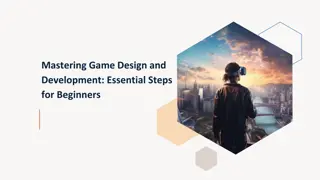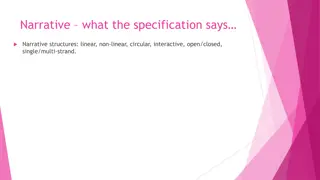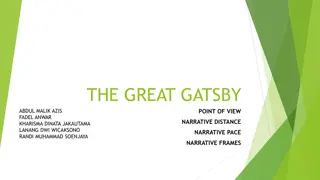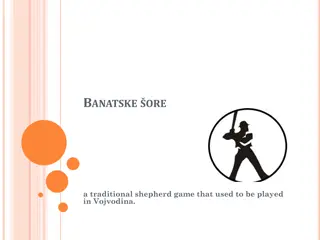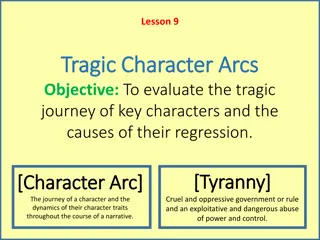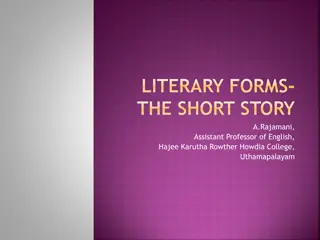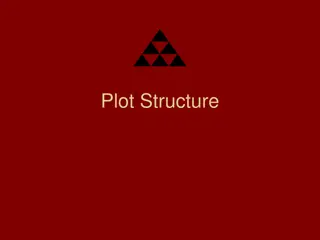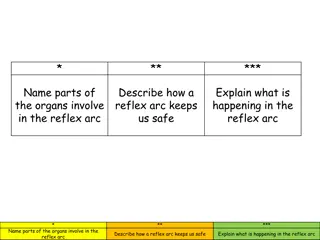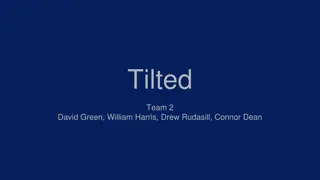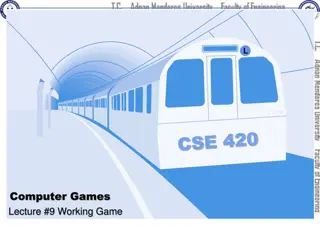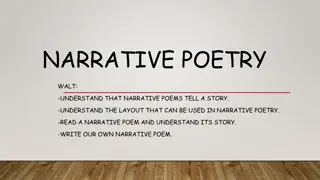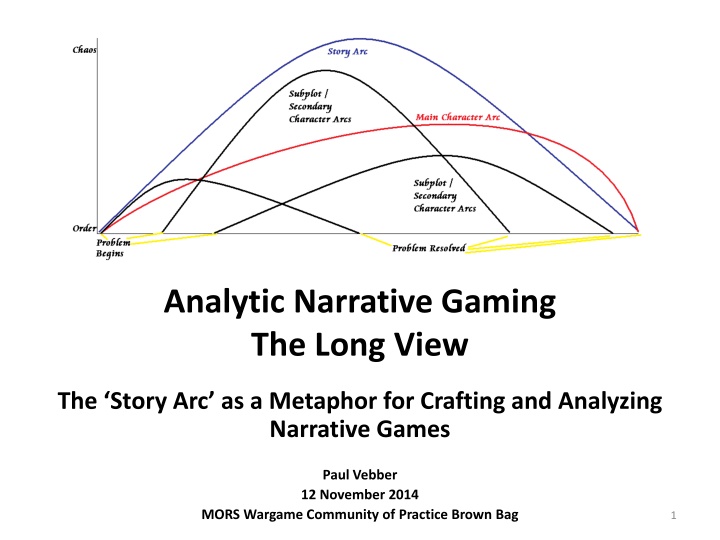
Crafting Analytic Narrative Games: Challenges and Strategies Explored
Explore the intersection of narrative and analytic games through challenges such as dealing with emergent events, understanding player decisions, and balancing perception of risk. Learn how to navigate the complexities of game design in this insightful analysis.
Download Presentation

Please find below an Image/Link to download the presentation.
The content on the website is provided AS IS for your information and personal use only. It may not be sold, licensed, or shared on other websites without obtaining consent from the author. If you encounter any issues during the download, it is possible that the publisher has removed the file from their server.
You are allowed to download the files provided on this website for personal or commercial use, subject to the condition that they are used lawfully. All files are the property of their respective owners.
The content on the website is provided AS IS for your information and personal use only. It may not be sold, licensed, or shared on other websites without obtaining consent from the author.
E N D
Presentation Transcript
Analytic Narrative Gaming The Long View The Story Arc as a Metaphor for Crafting and Analyzing Narrative Games Paul Vebber 12 November 2014 MORS Wargame Community of Practice Brown Bag 1
Gaming and the Cycle of Research Cycle of Research The interwar period is repeatedly hailed as one of the pinnacle periods of innovation in U.S. Naval History. What was it that enabled that to occur? Dr. Peter Perla describes a synergistic relationship he calls the cycle of research linking Exercises (doing), Analysis (assessing results), and Wargaming (exploring options). Increasingly sophisticated analysis methods and tools, together with increasingly severe time constraints bifurcated the uses of wargaming, some to a niche under M&S, or to various forms of interactive discussion ( BOGSAT ). The great middle ground was lost. A Winning Formula Diluted CDR Phil Pournelle http://www.usni.org/magazines/proceedings/2014-09/preparing-war-keeping-peace 2
Narrative vs Analytic Games Narrative Games Analytic Games ? Narrative Game: A category of game that draws upon and uses narrative strategies to create, guide, maintain, and lead the user through a fictional environment in order to actualize a narrative and ludic* goal. 1 Analytic Game: A category of game that draws upon and uses operations research techniques to enable the user to interact with competitors within an abstract representation of the real world in order to actualize an analytic** goal Analytic Narrative Gaming exists in the overlap between the two. Such a game provides a set of desired end-state characteristics for each player, but within a complex multi-actor situation requiring a combination of ludic and analytic gameplay. *Engagement to promote curiosity, engagement, and reflection. **Engagement to achieve a well-defined, pre-determined end state. 1 Jason Rhody http://misc.wordherders.net/?p=567
Challenges of Narrative Gaming Dealing with emergent events and behaviors Complex situations proceed in ways difficult to predict or adjudicate (assign cause) Representing perceived risk vs. uncertainty in assessing outcomes Presenting players with appropriate perception of risk and appropriate results Interactional vs. Structural complexity Assessing player decisions arising from other player s decisions vs. situational obstacles
Challenges of Analytic Gaming Deterministic models do not produce emergent results Players understand novel outcomes unlikely (pre-scripted injects at best) Probability in = Decisions out Players understand game simulation is Epistemic and play the perceived odds Tend to proceed linearly with deductive decision-making (MDMP) O_DA Loop the complex Orient step generally paid short shrift. Process-driven vice decision-driven
Dealing with Challenges Step 1 What do the actors do? What is their motivation? Identifying each actor s perception of the unfolding narrative Focus on the elements of communication Establishes the Plot Summary of what happened Questions remain: Alternative plot trajectories the paths not taken why? Sub-plots what emergent decisions and events influenced the course of events apart from actors intentions. Did the plot evolve in an expected or unexpected way? How do you explore/assess what might be expected .
Story Arc Metaphor Step 2 What do the actors do? What is their motivation? Based on the details of the environment they are placed in and what success criteria they are given. How do you get this right so the game is aimed in the right direction . Examine the choices presented before you play the game usuing a Story Arc view. Start with an idea of where the game may go then look back across multiple iterations. How may variations on the story arc were there? What caused divergence (or convergence)? Was there an unexpected or novel arc?
Example Simple trajectory Chaos A B C D Order Time Everyone cooperates with their neighbors. Without some kind of external stimulus to change, the status quo will continue in an orderly fashion. Repeated examination will produce some market noise but player trajectories will tend to rise and fall together, unless someone breaks from the pack arbitrarily. A player who does so constitutes a novel outcome unexpected from the initial conditions. Reasons for doing so may be interesting, or may simply be breaking character to see what happens . (e.g. : ) While the trajectory may be uninteresting, an analysis of specific actions and decisions from the point of view of the actors may well be. The mechanics of cooperation can be insightful.
Example Complicated trajectory Chaos Fail! A B New chaotic status quo C and D traj s merge? A and B traj s merge A and B traj s diverge again C D Win! C returns to status quo ante? Order Time B and D are in conflict, A and B cooperate while C and D cooperate A joins the conflict with D leading to a variety of choices by D (limited by ways and means): End the conflict, Ignore A and focus on B, Stall with B and attack A directly, Convince C to enter the conflict against B directly, Convince B to attack B or A indirectly, Undermine the cooperation between A and B, End overt conflict and continue to indirectly attack B In the diagram, D convinces C to indirectly attack A, while A enables B to indirectly attack C. What are the shapes the story arc can take from there to the next plot twist ? When you play the game several times, to you tend to get the same ones? Is that an artifact of the game design? The details of what the actors are doing continues to be vital, but examining the propensities of the story arc provides context for a higher level analysis of the course of additional iterations, or at least an idea of the paths not taken .
Example Complex trajectory All Fail! Chaos Some Fail! (but when) A B ? ? ? C D Win! Order Time B, C, and D are openly cooperative, but indirectly in conflict. A cooperates with B and C. The pot boils with indeterminate results until: B, C, and D all fail One or more fail and the remaining actors return to order. All decide to return to order A can be a wild card not understanding the internal dynamics but wanting to help may unwittingly drive the process increasingly into chaos, dragging it along as well. In the complicated situation, A can observe overt actions and make semi-informed decisions. In the complex situation, A must interpret the causation of events from what B, C, and D communicate. The details of what the actors are doing contribute to a tipping point where which action causes the final straw to break is indeterminate.
Challenges Redux Participants informed by what part of the story arc the game objectives are focused on can better avoid rabbit-holes or other narrative distractions. Players cognizant of the story arc place risk in a more appropriate context (even if not understood well) i.e. strategy in repeated prisoner s dilemma Scenario typology and examination of interactional complexities can inform issues with emergent behaviors and controlling structural complexities in the game design. Novel outcomes can be specifically sought, or avoided based on the game objectives and an exploration of the trajectories the game may take. Decision-making can be supported by M&S, but in producing a response, not as a crutch to formulating an input.
And the missing O in O_DA Loop The Big Reveal Boyd s Orient is No, not witchcraft despite all appearances
Largely Reasoning by Abduction! The Sandia Hybrid Model of Cognition Abduction is the search for patterns in phenomena that suggest a hypothesis (C.S. Peirce 1878) SANDIA REPORT SAND2001-3496 Unlimited Release Printed November 2001 Foundations for Reasoning in Cognition-Based Computational Representations of Human Decision Making http://www.au.af.mil/au/awc/awcgate/decision/raybourn-senglaub_013496.pdf
Goal: Understanding Patterns in Phenomena Using Iterated, Analytic Narrative Gaming Understanding what the players do and why is critical to the process. Understanding what else might have happened is equally critical to both the game design, and the analysis of iterated series of games. Significant up from work to work through the options players have across the story arc does not have to be exhaustive to be useful (prisoners dilemma). A complex undertaking to diagram out that requires substantial work to address problems of real world complexity to support post game retro-diction . Causal relationships in truly complex situations will never be isolated.



